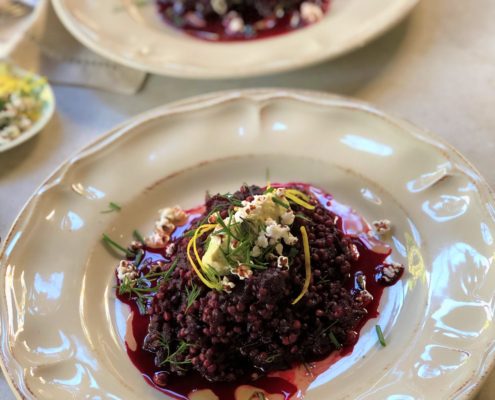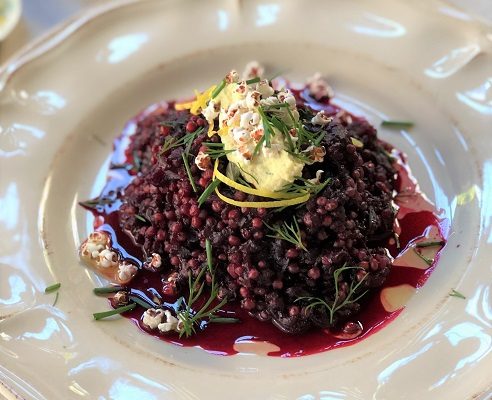Dominique Rizzo | Bespoke Food Tours
Vegan Beetroot Sorghum Risotto
Moderate
Preparation time 40 minutes – includes roasting beetroots Cooking time 45 mins
(Vegan / Gluten Free / Low Carb)
After having exhausted my quinoa, barley, freekah and varied rice supplies, I started looking at other grains which also nutritiously stand strong and are readily available. After a little research and recipe testing, I stumbled across the locally grown miraculous Sorghum.
When I say miraculous, I mean gluten-free, non GMO, contains less fat than quinoa, massively high in protein and fibre, full of powerful phytochemicals proven to fight off cancer and reduce the risk of cardiovascular disease and obesity.
It also has the potential to improve insulin and produce an anti-diabetic effect and it has a higher antioxidant and anti-inflammatory nature than blueberries and pomegranates! Why haven’t we heard more about this super grain?
Sorghum is relatively new to the superfood market although it has been around for over 8000 years. It is now the fifth most important cereal crop in the world, largely because of its natural drought tolerance and versatility as food, feed and fuel. Featuring on menus all over the world Sorghum has become more popular amongst recognised chefs who are looking for grain substitutes that are also very sustainable.
Ingredients
To prepare the sorghum grain, its best to soak the grain over night in water to allow it to soften slightly. Drain the grain, then using 1 cup of sorghum to 3 cups of water, bring the sorghum to a simmer and cook 40 – 50 minutes until its tender when eaten. Drain and then use as you wish. Sorghum is a fabulous grain to use it is very difficult to overcook. Sorghum has a wonderful nutty taste with a great texture and can be used for soups, stews, salads, breakfast porridge and risottos like the one below. You can pick up sorghum in both grain and flour form from most health shops and on line.
- 2 tablespoon olive oil
- 1/4 tsp crushed fennel seeds
- 1/2 cup finely chopped fennel, finely chopped
- 1/2 small brown onion finely chopped
- 4 cups beetroot juice – vegetable stock can be substituted
- 3 cups sorghum grain, boil in water for 40 minutes
- 1 ½ tblsp vegan butter
- 2 large roasted beetroot, peeled and grated on a large-hole box grater
- Salt and Pepper
- Popped sorghum – see recipe
- Cashew Dill Cheese – see recipe
- Soft herbs like dill, mint, chives or micro herbs
Cashew Dill Cheese Makes 2 ½ cups
- 2 cups raw cashews soaked overnight and drained
- 1 clove garlic or 1 tsp garlic powder
- 3 tblsp fresh dill, roughly chopped
- 1 tsp onion powder
- 4 tblsp nutritional yeast flakes
- 2 tblsp lemon juice
- 1/3 cup of water
- ¼ cup olive oil
- ¼ tsp salt
- Freshly ground black pepper
Lemon Popped Sorghum Makes about 1 cup
- 2 tblsp canola oil
- 1/3 cup uncooked sorghum
- Zest of 1 lemon
- Sprig of thyme, chopped
- 3 tblsp vegan butter
- Salt to taste
Recipe Steps
Beetroot Sorghum Risotto
- Heat oil in a large saucepan, fry the fennel seeds until fragrant. Add in chopped onion and fennel. Stir over medium heat until soft and cooked through. Stir in the beet juice and simmer until reduce by half. Add in the cooked sorghum, simmer for a further 30 minutes until most of the juice has been absorbed. Stir in butter, fresh grated beetroots and seasoning. To serve, top with the cashew cheese, popped sorghum, herbs and a squeeze of lemon.
Cashew Cheese
- For the Cashew Cheese, using a high speed blender or food processor, combine everything together except the water and oil. Blend until very smooth, add in the lemon juice and slowly drizzle is the olive oil, season and fold in the chopped dill. Store in the fridge for 5 to 6 days.
Lemon scented popped Sorghum
- Heat a medium saucepan over a moderately high heat. Tip in half of the sorghum, place a lid loosely on top of the pan. Cook for 1 minute or until the sorghum popping slows down, shake the pot, until most of the grains are popped. Remove the popped sorghum, and repeat. Into the same pan, melt the butter with the lemon zest and thyme. Season and set aside to pour over the popped Sourghum and risotto.



